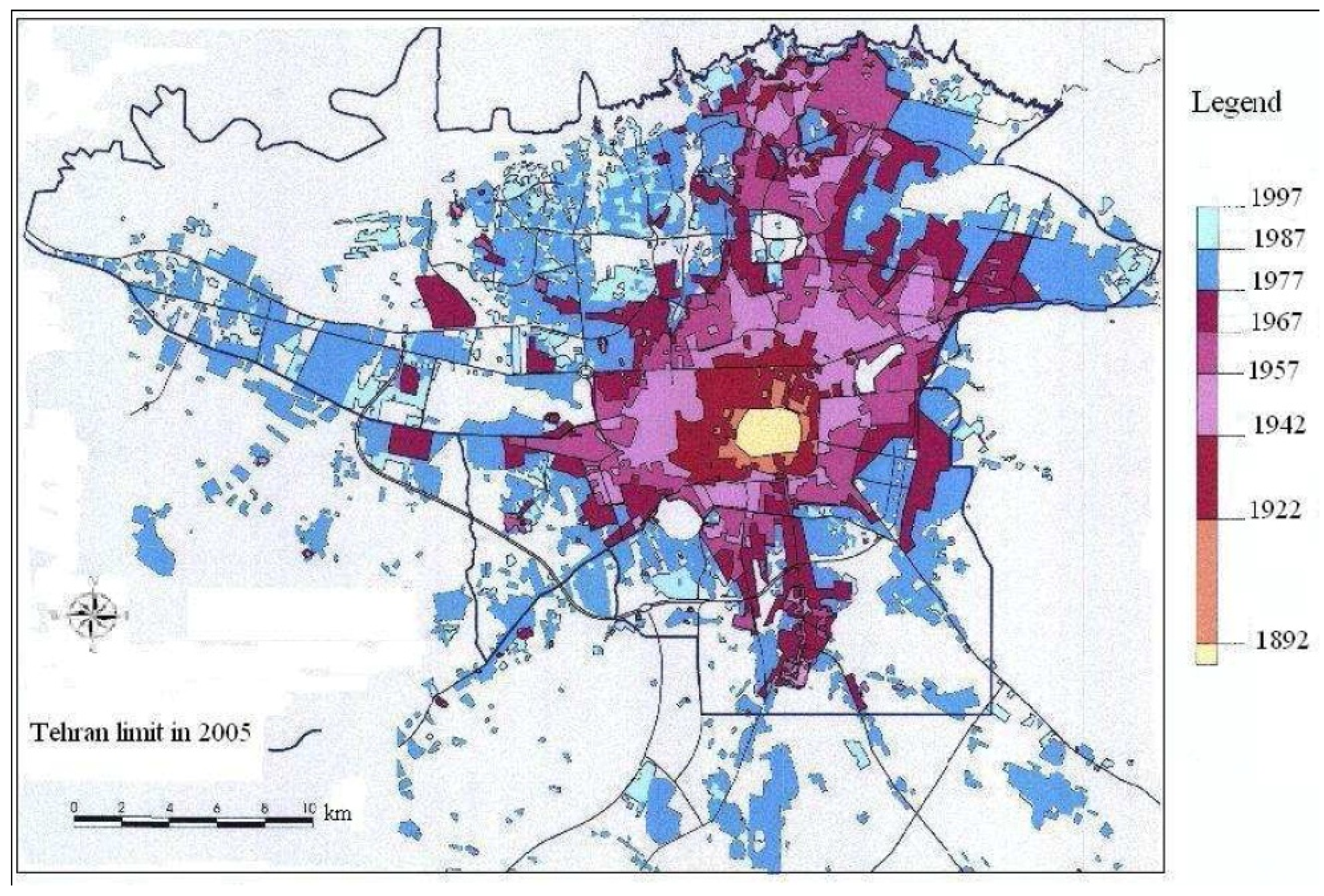New Climatic Indicators for Improving Urban Sprawl: A Case Study of Tehran City
Abstract
:1. Introduction
2. Materials and Methods
2.1. Studied Area
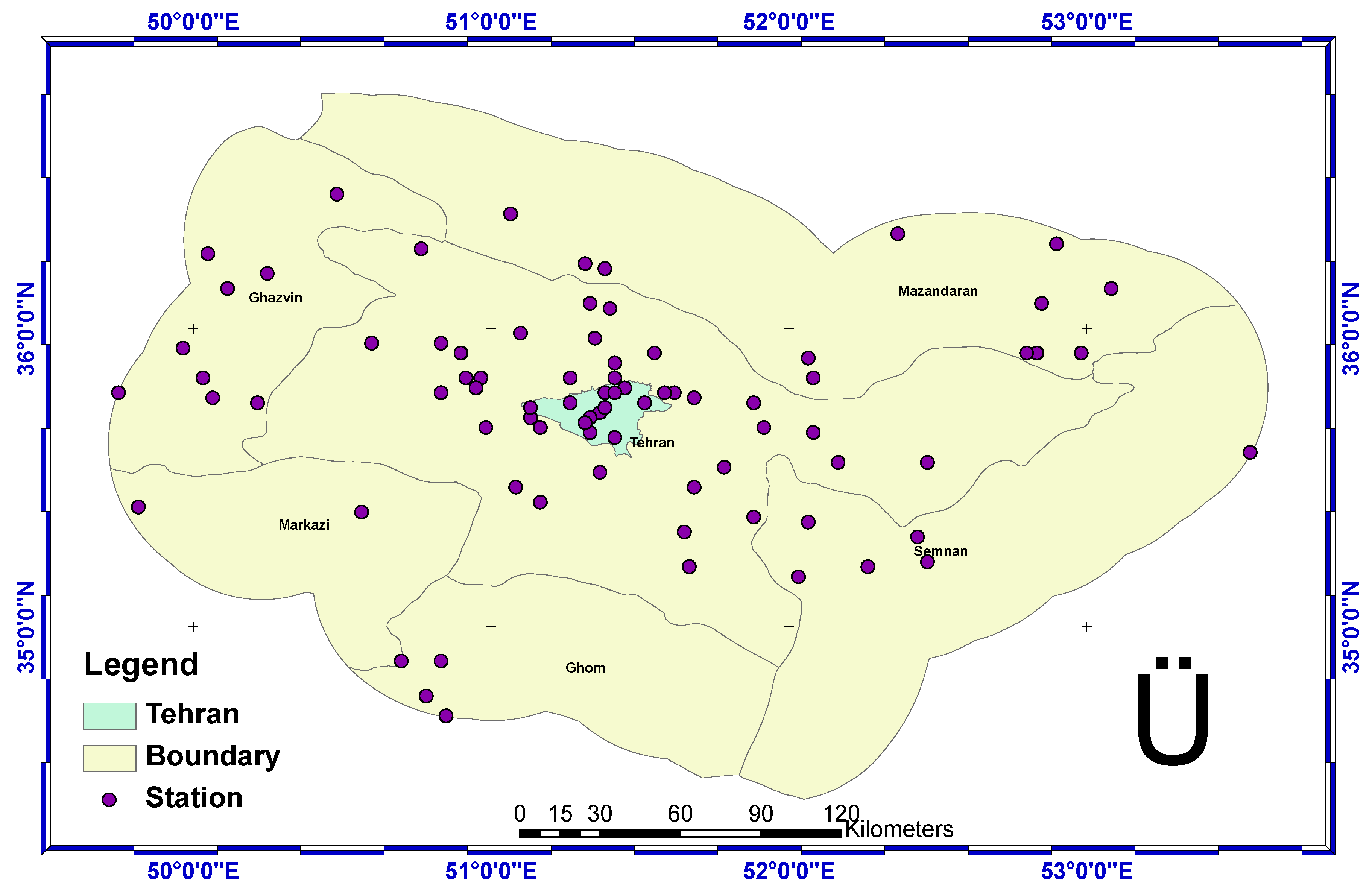
| Year | 1921 | 1931 | 1941 | 1956 | 1966 | 1976 | 1986 | 1996 | 2000 | 2006 |
|---|---|---|---|---|---|---|---|---|---|---|
| Population (million) | 0.21 | 0.3 | 0.69 | 1.51 | 2.71 | 4.5 | 6.04 | 6.7 | 7.02 | 7.711 |
| Area (hectarea) | 720 | 2,420 | 4,500 | 10,000 | 19,000 | 32,000 | 62,000 | 73,950 | 78,900 | 80l000 |
| Density (p/ha) | 291.6 | 124 | 154 | 151 | 143 | 141 | 97.4 | 91 | 88.9 | 96.3 |
| Private cars per 1,000 persons | - | - | - | 5 | 25 | 31 | 61 | 74 | 83 | 90 |
2.2. Meteorological Data Reconstruction Methods
2.3. Clustering Method and Preparation of Matrix Variables
- A)
- Preparing the raw data matrix;
- B)
- Calculating the raw data matrix;
- C)
- Forming the possible groups and calculating the Euclidian distance of each variable with its own group's average;
- D)
- Merging the groups by the method of minimum variance (the entering method) and determining the final grouping;
- E)
- Drawing the dendrogram which is the result of the merging of groups in several stages’
- F)
2.4. Shannon Entropy Indicator
2.5. Estimate Thermal Comfort Proposal Indicator

| Humidex range | Thermal comfort level |
|---|---|
| Less than 29 °C, | no discomfort |
| 30 °C-39 °C, | some discomfort |
| 40 °C-45 °C, | great discomfort |
| 45 °C-54 °C, | dangerous |
| Above 54 °C, | heat stroke imminent |
3. Results and Discussion
3.1. Urban Sprawl in Tehran
3.2. Validation of Simulated Data
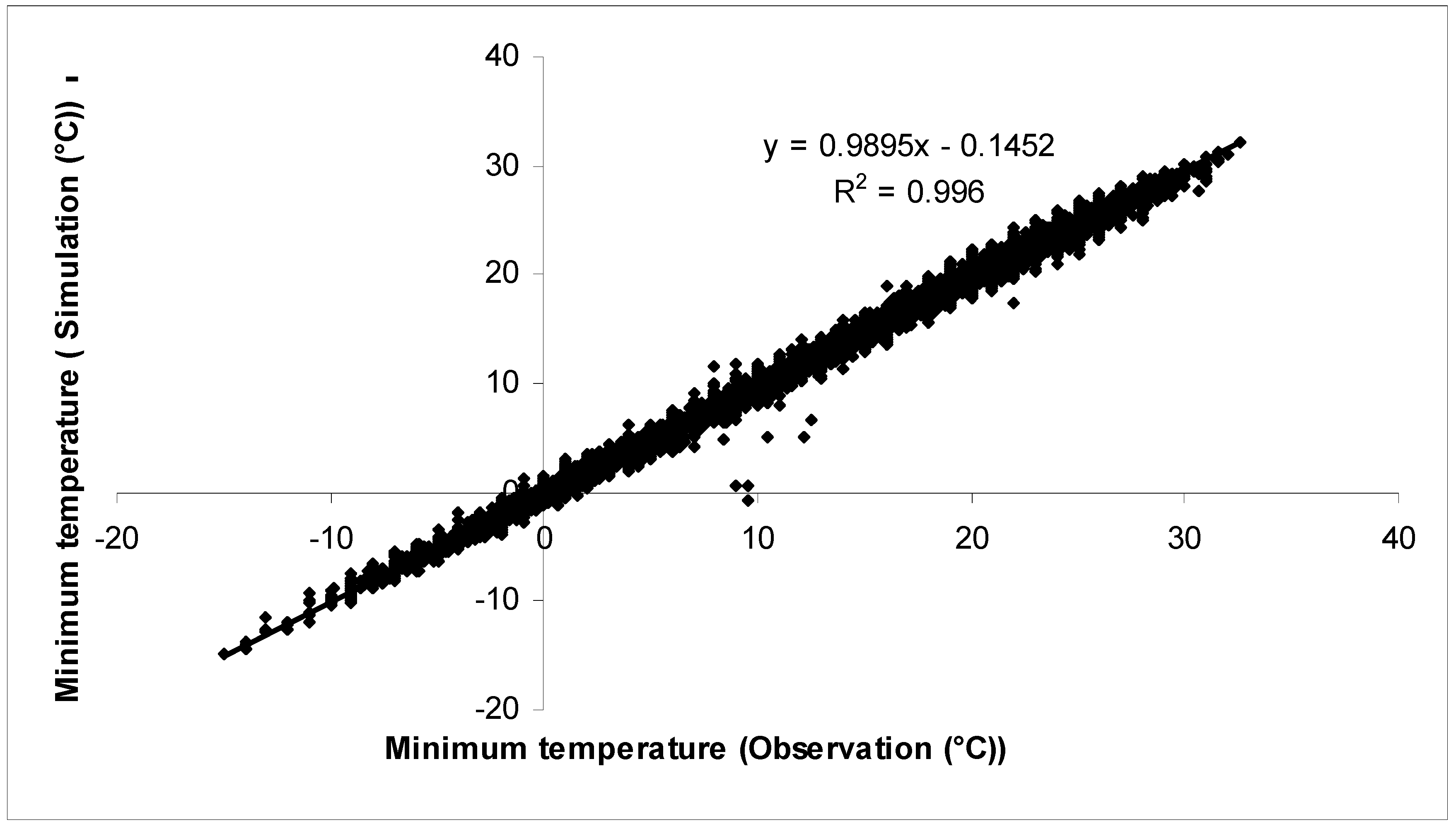
3.3. Essential Microclimates Indicators' Changes in Study Area
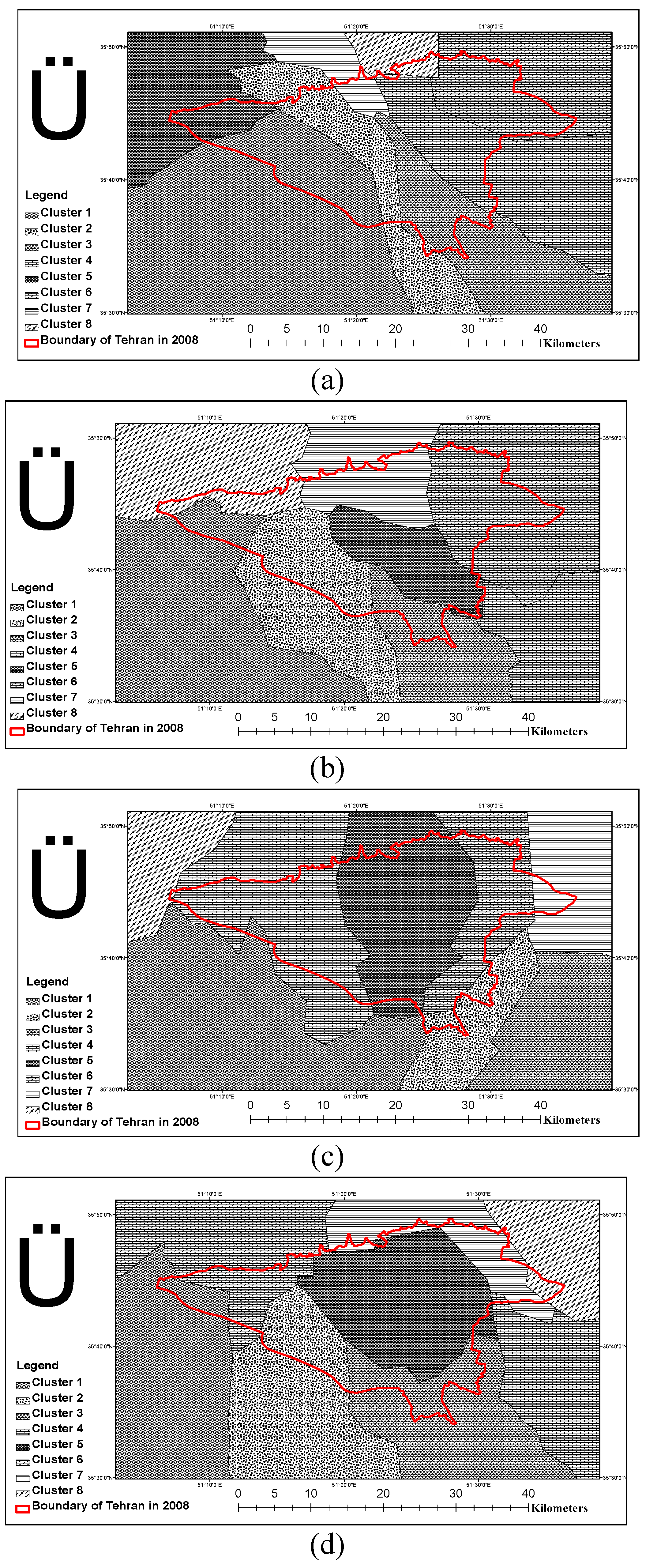
| Periods | Clusters | Min-Tem | Max-Hum | Max-Tem | Min-Hum | Ave-Tem | Ave-Hum |
|---|---|---|---|---|---|---|---|
| 1965-1975 | 1 | 9.67 | 51.06 | 23.01 | 33.44 | 16.34 | 42.25 |
| 2 | 9.15 | 51.1 | 22.16 | 34.82 | 15.655 | 42.96 | |
| 3 | 9.19 | 51.75 | 22.91 | 35.45 | 16.05 | 43.6 | |
| 4 | 9.04 | 52.52 | 21.82 | 36.84 | 15.43 | 44.68 | |
| 5 | 8.39 | 52.72 | 21.18 | 34.84 | 14.785 | 43.78 | |
| 6 | 8.08 | 53.51 | 20.07 | 38.29 | 14.075 | 45.9 | |
| 7 | 7.67 | 52.33 | 19.78 | 36.32 | 13.725 | 44.325 | |
| 8 | 7.04 | 53.09 | 18.76 | 37.72 | 12.9 | 45.405 | |
| 1976-1985 | 1 | 10.11 | 54.53 | 22.33 | 36.84 | 16.22 | 45.685 |
| 2 | 11.41 | 52.42 | 22.7 | 37.19 | 17.055 | 44.805 | |
| 3 | 10.95 | 53.83 | 23.11 | 39.86 | 17.03 | 46.845 | |
| 4 | 9.87 | 55.03 | 22.55 | 41.54 | 16.21 | 48.285 | |
| 5 | 11.05 | 52.9 | 22.34 | 41.5 | 16.695 | 47.2 | |
| 6 | 8.71 | 54.7 | 20.8 | 43.65 | 14.755 | 49.175 | |
| 7 | 8.53 | 53.48 | 19.92 | 42.17 | 14.225 | 47.825 | |
| 8 | 8.15 | 54.98 | 19.99 | 39.41 | 14.07 | 47.195 | |
| 1986-1995 | 1 | 10.96 | 56.89 | 22.75 | 37.79 | 16.855 | 47.34 |
| 2 | 10.44 | 55.89 | 21.96 | 42.1 | 16.2 | 48.995 | |
| 3 | 9.33 | 58.66 | 21.27 | 45.38 | 15.3 | 52.02 | |
| 4 | 11.07 | 53.65 | 21.62 | 37.5 | 16.345 | 45.575 | |
| 5 | 11.09 | 50.56 | 21.06 | 38.79 | 16.075 | 44.675 | |
| 6 | 10 | 52.27 | 19.97 | 41.25 | 14.985 | 46.76 | |
| 7 | 8.68 | 53.89 | 18.54 | 43.87 | 13.61 | 48.88 | |
| 8 | 9.63 | 59.06 | 20.94 | 38.8 | 15.285 | 48.93 | |
| 1996-2005 | 1 | 12.12 | 53.77 | 23.15 | 35.18 | 17.635 | 44.475 |
| 2 | 13.02 | 52.79 | 23.75 | 35.65 | 18.385 | 44.22 | |
| 3 | 12.45 | 51.97 | 23.31 | 36.74 | 17.88 | 44.355 | |
| 4 | 11.18 | 53.06 | 22.16 | 39.29 | 16.67 | 46.175 | |
| 5 | 12.69 | 49.47 | 21.77 | 36.71 | 17.23 | 43.09 | |
| 6 | 11.83 | 53.78 | 21.8 | 37.4 | 16.815 | 45.59 | |
| 7 | 11.63 | 51.89 | 20.73 | 39.78 | 16.18 | 45.835 | |
| 8 | 10.49 | 54.59 | 20.31 | 42.67 | 15.4 | 48.63 |
3.4. Calculating Nucleus Microclimate Entropy Values in Different Decades
| Periods | Area in | ||||
|---|---|---|---|---|---|
| Clusters | 1966-1975 | 1976-1985 | 1986-1995 | 1996-2005 | |
| 1 | 705.8 | 508.4 | 553.1 | 387.8 | |
| 2 | 214.1 | 285.3 | 152.7 | 348.1 | |
| 3 | 267.6 | 188.4 | 242.6 | 309.8 | |
| 4 | 332.3 | 198.2 | 404.0 | 220.0 | |
| 5 | 260.3 | 134.2 | 335.0 | 303.8 | |
| 6 | 286.0 | 420.5 | 184.3 | 305.5 | |
| 7 | 78.6 | 193.4 | 192.2 | 167.4 | |
| 8 | 59.5 | 275.7 | 140.2 | 161.7 | |
| total | 2,204.1 | 2,204.1 | 2,204.1 | 2,204.1 | |
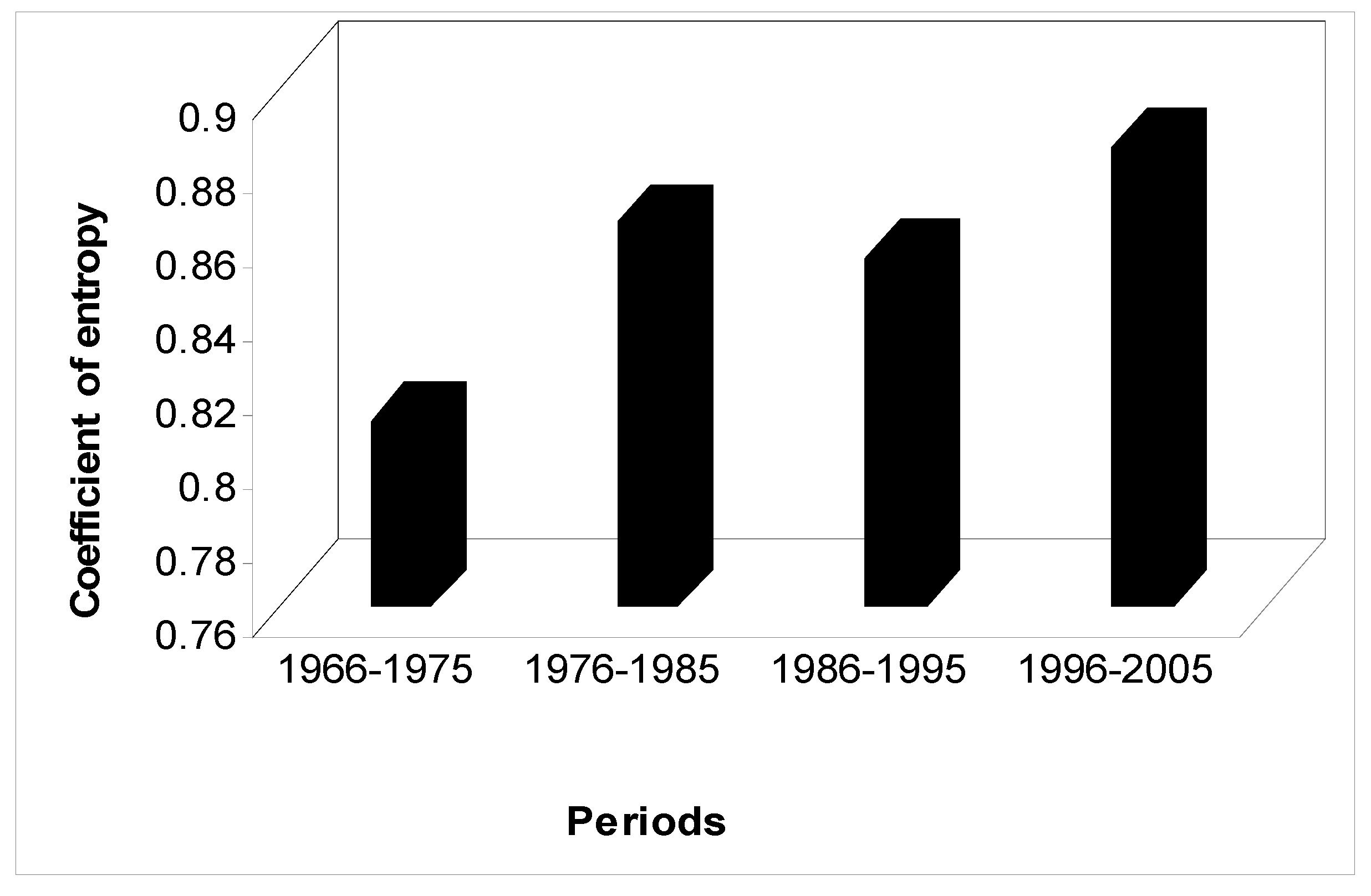
3.5. Microclimate Changes and Urban Sprawl
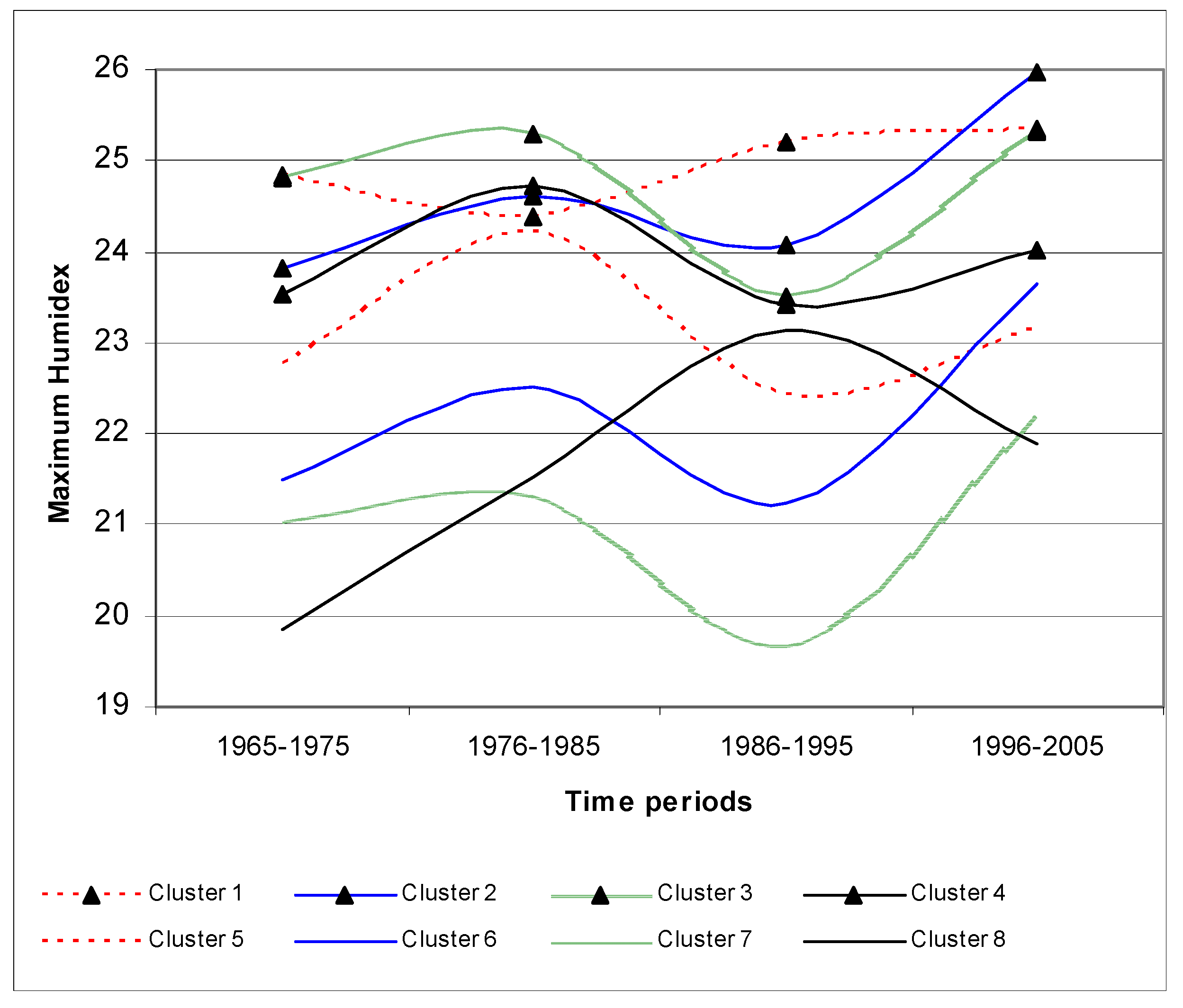
4. Conclusions
References and Notes
- Fistola, R. The unsustainable city. Urban entropy and social capital: the needing of a new urban planning. Procedia. Eng. 2011, 21, 976–984. [Google Scholar] [CrossRef]
- Chen, Y. The rank-size scaling law and entropy-maximizing principle. Physica A 2012, 391, 767–778. [Google Scholar] [CrossRef]
- Liang, C.L.; Zhang, Z.L. Fuzzy assessment of water resources carrying capacity based on maximum entropy theory: A case study on Feicheng City. Water Res. Protection. 2006, 6, 35–37. [Google Scholar]
- Jin, J.L.; Hong, T.Q.; Wng, W.S. Entropy and FAHP based fuzzy comprehensive evaluation model of water resources sustaining utilization. J. Hydroelectr. Eng. 2007, 26, 22–28. [Google Scholar]
- Yang, W.; Tong, X.H.; Liu, M.L. Analysis of pattern change of entropy based land use. J. Tongji Univ. (Nat. Sci.). 2004, 31, 69–72. [Google Scholar]
- Chen, H.; Liu, Y. Establishment and application of thermodynamics entropy to road traffic system. J. Hunan Univ. (Nat. Sci.). 2004, 31, 69–72. [Google Scholar]
- He, D. Evaluation system build and policy study on regional circular economy development. Master's thesis; Wuhan University of Technology: Wuhan, China, 2006. http://www.dissertationtopic.net/doc/1094725 (Accessed 2013).
- Wang, X.; Su, J.; Shan, S.; Zhang, Y. Urban ecological regulation based on information entropy at the town scale. A case study on Tongzhou district, Beijing City. Procedia. Env. Sci. 2012, 13, 1155–1164. [Google Scholar]
- Sarvestania, M.S.; Ibrahima, Ab.L.; Kanarogloub, P. Three decades of urban growth in the city of Shiraz, Iran: A remote sensing and geographic information system applications. Cities 2011, 28, 320–329. [Google Scholar] [CrossRef]
- Sun, H.; Forsythe, W.; Waters, N. Modeling Urban land Use Change and Urban Sprawl: Calgary, Alberta, Canada. Netw. Spat. Econ. 2007, 7, 353–376. [Google Scholar] [CrossRef]
- Verzosa, L.C.O.; Gonzalez, R.M. Remote sensing, geographic information systems and Shannon’s Entropy: measuring urban sprawl in a mountainous environment. In ISPRS TC VII Symposium-100 Years ISPRS, Vienna, Austria, July 5–7, 2010. IAPRS 38, Part 7A.
- Joshi, J.P.; Bhatt, B. Quantifying urban sprawl: A case study of Vadodara Taluka. Geo. Res. 2011, 1, 34–37. [Google Scholar]
- Jyotishman, D.; Om, P.T.; Mohamed, L.K. Urban growth trend analysis using Shanon Entropy approach- A case study in North-East India. Int. J. Geol. 2012, 2, 1062–1068. [Google Scholar]
- Mobaraki, O.; Mohammadi, J.; Zarabi, A. Urban form and sustainable development: the case of Urmia City. J. Geogr. Geol. 2012, 4, 1–12. [Google Scholar] [CrossRef]
- Zhang, T. Land market forces and government’s role in sprawl, the case of China. Cities 2000, 17, 123–135. [Google Scholar] [CrossRef]
- Jeffrey, A.C.; Foley, J.A. Agricultural land-use change in Brazilian Amazonia between 1980 and 1995: Evidence from integrated satellite and census data. Remote Sens. Environ. 2003, 87, 551–562. [Google Scholar]
- Tan, M.; Li, X.; Xie, H.; Lu, C. Urban land expansion and arable land loss in China-A case study of Beijing–Tianjin–Hebei region. Land Use Policy 2005, 22, 187–196. [Google Scholar] [CrossRef]
- Shahraki, S.Z. The analysis of Tehran urban sprawl and its effect on agricultural lands. M.A. Thesis in Geography and Urban Planning, University of Tehran, Iran, 2007. [Google Scholar]
- Brabec, E.; Smith, C. Agricultural land fragmentation: the spatial effects of three land protection strategies in the eastern United States. Landsc. Urban Plan. 2002, 58, 255–268. [Google Scholar] [CrossRef]
- Pourahmad, A.; Baghvand, A.; Shahraki, S.Z.; Givehchi, S. The impact of urban sprawl up on air pollution. Int. J. Environ. 2007, 1, 252–257. [Google Scholar]
- Brueckner, J.K.; Largey, A.G. Social interaction and urban sprawl. J. Urban Econ. 2007, 10, 1–17. [Google Scholar] [CrossRef]
- Pars Fuel. The Company of Fuel and Oil Products in Iran. data service. 2010; Tehran, Iran. (in Persian) [Google Scholar]
- Iranian Statistics Center. Second Report in Censes of People and Housing. Tehran, Iran, 1986. (in Persian) [Google Scholar]
- The Center of Studies and Planning of Tehran Municipality. Office of Air pollution and physical structure of Tehran city. Local data service. Tehran, Iran, 2005. [Google Scholar]
- The Ministry of Housing and Urban Planning of Iran, report about the view of deconstruction from Tehran. Tehran, Iran, 2003.
- Roshan, Gh.R.; Shahraki, S.Z.; Sauri, D.; Borna, R. Urban sprawl and climatic changes in tehran Iran. J. Environ. Health. Sci. Eng. 2010, 7, 43–52. [Google Scholar]
- Roshan, Gh.R.; Rousta, I.; Ramesh, M. Studying the effects of urban sprawl of metropolis on tourism-climate index oscillation: A case study of Tehran city. J. Geo Reg. Plan. 2009, 2, 310–321. [Google Scholar]
- Habibi, M.; Hurcade, B. Atlas of Tehran Metropolis, published by Analysis and Urban planning. Tehran municipality, 2005; 50–57. (in Persian) [Google Scholar]
- Mehdizadeh, J. Period of rehabilitation and formation of Tehran metropolis (in Persian). J. Jostarhaye shahrsazi. 2003, 3, 26–32. [Google Scholar]
- Dehaghani, N. An analysis of urban planning features in Iran, Science and Technology University of Iran Press. Tehran, Iran, 2004. (in Persian) [Google Scholar]
- Sadeghi, R. Regional classification agriculture in southern Iran. J. Arid Environ. 2002, 50, 77–98. [Google Scholar] [CrossRef]
- DeGaetano, A.T.; Shulman, M.D. A climatic classification of plant hardiness in the United States and Canada. Agr. Forest. Meteorol. 1990, 51, 333–351. [Google Scholar] [CrossRef]
- Fovell, R.G.; Fovell, M.Y. Climate zones of the conterminous united states defined using cluster analysis. J. Climate 1993, 6, 2103–2135. [Google Scholar] [CrossRef]
- Johnson, G.L.; Hanson, C.L.; Hardegree, S.P.; Ballard, E.B. Stochastic weather simulation: overview and analysis of two commonly used models. J. Appl. Meteorol. 1996, 35, 1878–1896. [Google Scholar] [CrossRef]
- Carlucci, S.; Pagliano, L. A review of indices for the long-term evaluation of the general thermal comfort conditions in buildings. Energ. Build. 2012, 53, 194–205. [Google Scholar] [CrossRef]
- Rainham, D.G.C.; Smoyer-Tomic, K.E. The role of air pollution in the relationship between a heat stress index and human mortality in Toronto. Environ. Res. 2003, 93, 9–19. [Google Scholar] [CrossRef]
© 2013 by the authors; licensee MDPI, Basel, Switzerland. This article is an open access article distributed under the terms and conditions of the Creative Commons Attribution license (http://creativecommons.org/licenses/by/3.0/).
Share and Cite
Ghanghermeh, A.; Roshan, G.; Orosa, J.A.; Calvo-Rolle, J.L.; Costa, Á.M. New Climatic Indicators for Improving Urban Sprawl: A Case Study of Tehran City. Entropy 2013, 15, 999-1013. https://doi.org/10.3390/e15030999
Ghanghermeh A, Roshan G, Orosa JA, Calvo-Rolle JL, Costa ÁM. New Climatic Indicators for Improving Urban Sprawl: A Case Study of Tehran City. Entropy. 2013; 15(3):999-1013. https://doi.org/10.3390/e15030999
Chicago/Turabian StyleGhanghermeh, Abdolazim, Gholamreza Roshan, José A. Orosa, José L. Calvo-Rolle, and Ángel M. Costa. 2013. "New Climatic Indicators for Improving Urban Sprawl: A Case Study of Tehran City" Entropy 15, no. 3: 999-1013. https://doi.org/10.3390/e15030999
APA StyleGhanghermeh, A., Roshan, G., Orosa, J. A., Calvo-Rolle, J. L., & Costa, Á. M. (2013). New Climatic Indicators for Improving Urban Sprawl: A Case Study of Tehran City. Entropy, 15(3), 999-1013. https://doi.org/10.3390/e15030999






